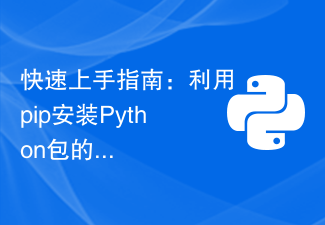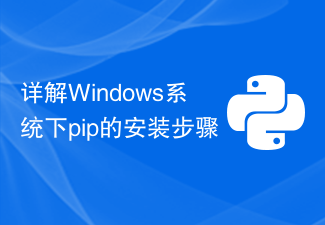 Backend Development
Backend Development Python Tutorial
Python Tutorial Simple and efficient: use pip to install and manage Python libraries
Simple and efficient: use pip to install and manage Python libraries
Time-saving and convenient: use pip installation commands to manage Python libraries, specific code examples are required
With the continuous development of Python, more and more third-party libraries are available and modules were developed to provide us with more features and options. However, before using these libraries, we need to install them into our Python environment. As a package management tool for Python, pip allows us to quickly and easily install and manage the libraries we need.
pip is Python's package management tool, which allows us to easily install and manage Python libraries. Its full name is "pip installs packages", and its purpose is to allow us to easily install and upgrade Python libraries. pip has become a standard in the Python community, and almost all Python libraries can be installed using the pip command.
Before starting to use pip, we need to ensure that our Python environment has been correctly installed and configured. Generally speaking, if we are using a Python version greater than or equal to 2.7.9 or 3.4, pip is already included in the Python installation package. We can check whether pip is installed by entering the pip command in the terminal or command prompt.
The following are some commonly used pip commands:
-
Installation library
To install a Python library, you can use the following command:
pip install <库名>
Where
<library name></library>is the name of the library that needs to be installed. For example, to install the numpy library, you can use the following command:pip install numpy
-
Upgrade library
If we need to upgrade an already installed library, you can use the following command:
pip install --upgrade <库名>
where
<library name></library>is the name of the library that needs to be upgraded. For example, to upgrade the numpy library, you can use the following command:pip install --upgrade numpy
-
Uninstall library
If we need to uninstall an installed library from the Python environment, we can use the following Command:
pip uninstall <库名>
where
<library name></library>is the name of the library that needs to be uninstalled. For example, to uninstall the numpy library, you can use the following command:pip uninstall numpy
-
Search library
If we need to search the name of the Python library, we can use the following command:
pip search <关键词>
where
<keywords></keywords>is the keyword to be searched. For example, to search for libraries related to data analysis, you can use the following command:pip search 数据分析
By using the pip command, we can easily install, upgrade, and uninstall Python libraries. Not only does pip save time, it's also very simple to use. Both beginners and experienced developers can easily use pip to manage Python libraries.
In daily Python development, we often need to use some commonly used libraries, such as numpy, pandas, matplotlib, etc. Below are some specific code examples showing how to use the pip command to install these commonly used libraries.
Install numpy library:
pip install numpy
Upgrade numpy library:
pip install --upgrade numpy
Uninstall numpy library:
pip uninstall numpy
Search for libraries related to data analysis:
pip search 数据分析
These code examples can help you better understand and learn how to use the pip command to install and manage Python libraries.
In summary, pip is a very important tool in Python development. It allows us to save time and conveniently install and manage Python libraries. By mastering the use of pip, we can easily install the required libraries and improve our development efficiency. I hope the introduction and examples in this article can help you better understand and use pip.
The above is the detailed content of Simple and efficient: use pip to install and manage Python libraries. For more information, please follow other related articles on the PHP Chinese website!
 解决pip安装缓慢问题,试试这个pip国内源教程Jan 17, 2024 am 09:13 AM
解决pip安装缓慢问题,试试这个pip国内源教程Jan 17, 2024 am 09:13 AM遇到pip安装慢?试试这个pip国内源教程,需要具体代码示例概述:在使用Python进行开发的过程中,我们经常会使用pip命令来安装各种依赖包。然而,由于众所周知的原因,国外的pip源有时候会变得非常慢,甚至无法连接。针对这个问题,我们可以使用国内的pip源来加快下载速度。本文将介绍如何配置国内的pip源,并给出具体的代码示例。步骤一:备份原有源文件在开始配
 加快pip下载速度的方法Feb 02, 2024 pm 12:03 PM
加快pip下载速度的方法Feb 02, 2024 pm 12:03 PM如何解决pip下载速度慢的问题引言:在使用Python进行开发时,我们经常会使用到pip工具来安装各种第三方模块。然而,有时候我们会遇到pip下载速度慢的问题,这会给我们的开发工作带来一些困扰。本文将介绍一些解决pip下载速度慢问题的方法,并给出具体的代码示例,帮助读者更好地解决这个问题。一、更换pip源pip默认会使用官方的源来下载模块,但是由于网络环境的
 简单使用pip安装whl文件的步骤Jan 04, 2024 pm 01:04 PM
简单使用pip安装whl文件的步骤Jan 04, 2024 pm 01:04 PM如何使用pip轻松安装whl文件在Python开发中,我们经常会使用到各种第三方库来提供额外的功能支持。而pip作为Python的包管理工具,能够快速安装和管理这些第三方库。通常我们使用pip来安装库时,是通过执行pipinstall命令加上库名来进行安装的。不过有些时候,我们会遇到一种特殊的情况:需要安装一个.whl文件而不是常规的.py文件。那么如何使
 清华镜像如何安装python库Nov 24, 2023 pm 02:09 PM
清华镜像如何安装python库Nov 24, 2023 pm 02:09 PM清华镜像安装python库的步骤:1、打开终端或命令行界面;2、确保已经配置好了清华镜像源,将清华镜像源设置为pip的默认源;3、运行“pip install <package-name>”命令来安装Python库;4、如果需要安装特定版本的库,可以在安装命令后面加上版本号“pip install <package-name>@<version>”等。
 了解pip安装包存储的位置和结构Jan 18, 2024 am 08:23 AM
了解pip安装包存储的位置和结构Jan 18, 2024 am 08:23 AM深入了解pip安装的包存放位置,需要具体代码示例pip是Python语言常用的包管理工具,用于方便地安装、升级和管理Python包。在使用pip安装包时,它会自动从PyPI(Python包索引)下载对应的包文件,并将其安装到指定的位置。那么,pip安装的包究竟存放在哪里呢?这是很多Python开发者都会遇到的问题。本文将深入探讨pip安装的包存放位置,并提供
 什么是用于隐马尔可夫模型的最佳Python库?Aug 30, 2023 pm 06:45 PM
什么是用于隐马尔可夫模型的最佳Python库?Aug 30, 2023 pm 06:45 PM隐马尔可夫模型(HMM)是用于对序列数据建模的强大统计模型类型。它们在语音识别、自然语言处理、金融和生物信息学等众多领域都有用途。Python是一种多功能编程语言,提供了一系列用于实施HMM的库。在本文中,我们将发现用于HMM的独特Python库,并评估它们的功能、性能和易用性,迟早会揭示满足您需求的最佳选择。隐马尔可夫模型入门在深入了解这些库之前,让我们简要回顾一下HMM的概念。HMM是一种概率模型,表示系统随时间在隐藏状态之间转换的情况。它由以下部分组成- 一组隐藏状态初始状态概率分布状态转
 快速上手指南:利用pip安装Python包的方法Jan 04, 2024 am 09:29 AM
快速上手指南:利用pip安装Python包的方法Jan 04, 2024 am 09:29 AM简明易懂的教程:如何使用pip安装Python包随着Python语言在科学计算、数据分析、Web开发等领域的普及和应用,越来越多的Python包被开发出来,以提供各种各样的功能和工具。而pip作为Python的包管理工具,大大方便了我们安装、升级和删除这些包。本教程将详细介绍如何使用pip来安装Python包,同时附上具体的代码示例,方便读者理解和操作。步骤
 详解Windows系统下pip的安装步骤Jan 17, 2024 am 09:00 AM
详解Windows系统下pip的安装步骤Jan 17, 2024 am 09:00 AMWindows系统下Pip的安装教程详解我们都知道,Pip是Python的一个包管理工具,方便我们在Python环境下安装、升级、卸载第三方库。在Windows系统上安装Pip可能有些繁琐,但只要按照以下步骤进行操作,你就能轻松完成安装。下载get-pip.py文件首先,我们需要下载Pip的安装文件get-pip.py。你可


Hot AI Tools

Undresser.AI Undress
AI-powered app for creating realistic nude photos

AI Clothes Remover
Online AI tool for removing clothes from photos.

Undress AI Tool
Undress images for free

Clothoff.io
AI clothes remover

AI Hentai Generator
Generate AI Hentai for free.

Hot Article

Hot Tools

PhpStorm Mac version
The latest (2018.2.1) professional PHP integrated development tool

Safe Exam Browser
Safe Exam Browser is a secure browser environment for taking online exams securely. This software turns any computer into a secure workstation. It controls access to any utility and prevents students from using unauthorized resources.

SublimeText3 English version
Recommended: Win version, supports code prompts!

Dreamweaver CS6
Visual web development tools

SublimeText3 Mac version
God-level code editing software (SublimeText3)





